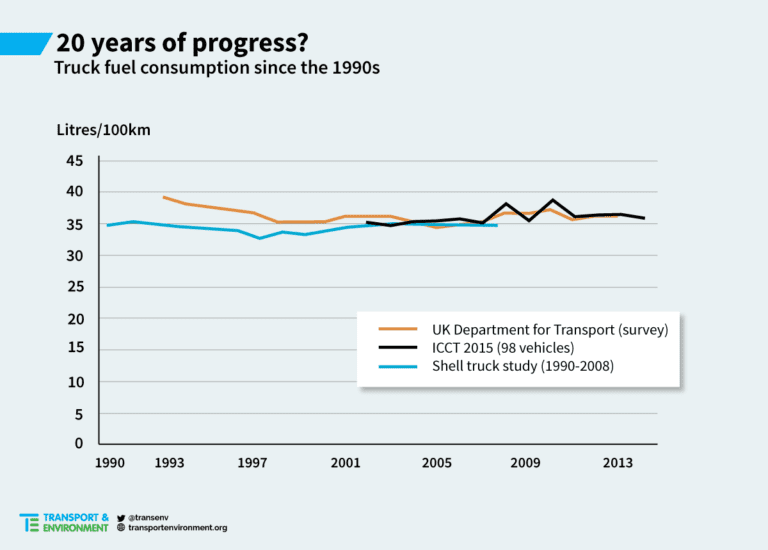Are you interested in this kind of news?
Receive them directly in your inbox. It is delivered once a week.
New truck fuel economy standards in the United States mean its heavy-duty vehicles will outperform their European counterparts in the near future, the International Council on Clean Transportation study found. Europe’s stagnant truck fuel economy has coincided with a trend toward heavier vehicles and larger engines.
William Todds, freight director at T&E, said: “Truck makers claim we can trust them to deliver more efficient trucks. The reality is that they have made almost no progress in fuel efficiency over the past decade, while they have allegedly run a cartel for most of that time. It’s time to change gears and introduce fuel economy standards for trucks.
Truck emissions in Europe have risen sharply in recent decades – 36% between 1990 and 2010, despite the 2008 economic crisis – due to high mileage and fuel consumption exceeding 30 liters per 100 km on average. CO2 emissions are directly linked to fuel economy in internal combustion vehicles, with more fuel efficient vehicles producing less greenhouse gases.
Pressure has been growing on the European Union to act on truck fuel efficiency standards since the US Environmental Protection Agency in June proposed a new target of 24% for truck fuel economy improvement by 2027, in addition to limits introduced in 2011. Four countries have EU The European Commission has told that restrictions on carbon dioxide emissions from trucks are essential if the EU wants to achieve its 2030 climate goals. (1)
“The Commission’s lack of progress on truck CO2 is astonishing. A decade after EU leaders first called for a strategy to reduce carbon emissions from trucks, we haven’t even decided how we will measure CO2 from trucks. Meanwhile, the Americans have The first CO2 limits for trucks were in 2011, and now the EPA is finalizing new post-2020 goals.
The Commission and EU truck makers have been working together since 2010 to carry out tests to measure truck fuel consumption. The tests are based on a software simulation tool called VECTO, which will gradually become mandatory for new trucks from 2018.
European manufacturers still enjoy a leading position in the global truck market, accounting for more than 40% of total global production.
Note to editors:
(1) Belgium, the Netherlands, Slovenia and the United Kingdom told the European Commission in June that limits on CO2 emissions from trucks were essential if the EU was to meet its 2030 climate targets.
https://www.transportenvironment.org/press/four-countries-back-truck-co2-…
for more information:
Read T&E’s summary: The Lost Decade of Truck Fuel Economy in Europe





